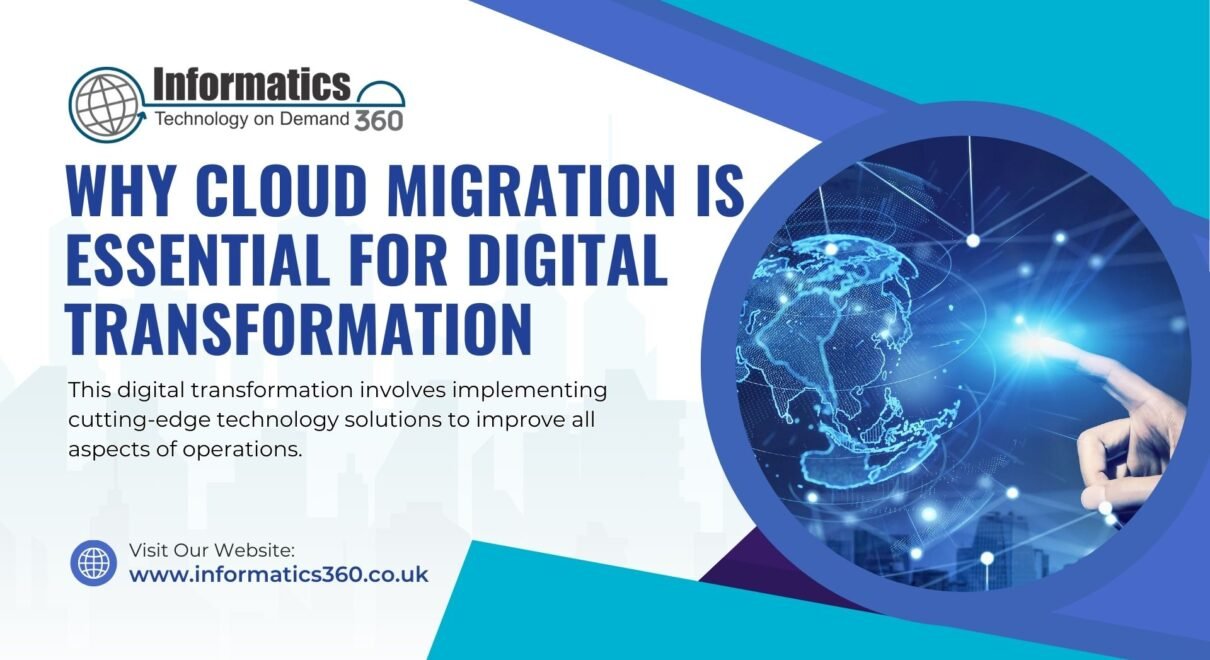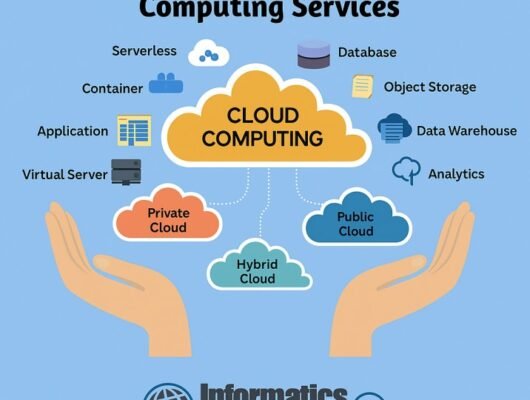In today’s competitive business landscape, digital transformation is no longer optional. Companies must innovate, streamline operations, and deliver value to customers more efficiently than ever. One of the most powerful enablers of this transformation is cloud computing. Migrating to the cloud is no longer just a technical decision; it is a strategic move that can determine the future growth and resilience of an organization.
Cloud migration refers to the process of moving an organization’s applications, data, and workloads from on-premises infrastructure to cloud-based environments. This transition allows businesses to leverage scalable, flexible, and cost-effective computing resources, driving innovation and operational efficiency. In this article, we explore why cloud migration is essential for digital transformation and how it empowers businesses to thrive in a rapidly evolving digital world.
Understanding Digital Transformation
Digital transformation is the process of using technology to fundamentally change how a business operates and delivers value to its customers. It involves rethinking business models, processes, and customer interactions to improve efficiency, innovation, and competitiveness.
Traditional IT infrastructure often limits the pace of digital transformation. Legacy systems can be expensive to maintain, difficult to scale, and less agile in responding to changing business needs. Cloud computing addresses these limitations by offering a modern, flexible, and scalable environment that aligns with the goals of digital transformation.
Key Benefits of Cloud Migration
Migrating to the cloud provides numerous advantages that directly contribute to digital transformation.
1. Scalability and Flexibility
Cloud environments allow businesses to scale computing resources up or down based on demand. This flexibility ensures that companies can respond quickly to market changes, seasonal demand fluctuations, or unexpected business growth without overinvesting in physical infrastructure.
Scalability also supports experimentation and innovation. Organizations can deploy new applications or services in the cloud without the constraints of traditional infrastructure, enabling faster time-to-market and increased competitiveness.
2. Cost Efficiency
Maintaining on-premises servers requires significant capital investment in hardware, software, and maintenance. Cloud migration shifts these costs to an operational expense model, where businesses pay only for the resources they use.
This cost efficiency allows companies to allocate budgets toward innovation and growth initiatives rather than routine maintenance. Cloud services also reduce energy consumption and physical space requirements, further lowering operational costs.
3. Enhanced Collaboration and Remote Work
Cloud computing facilitates collaboration by enabling employees to access applications and data from anywhere, at any time. This is particularly important in today’s environment where remote work is increasingly common.
By centralizing resources in the cloud, teams can work simultaneously on projects, share real-time updates, and improve productivity. Collaboration tools hosted in the cloud ensure seamless communication and project management, breaking down geographical barriers.
4. Improved Security and Compliance
Security concerns are often cited as barriers to digital transformation. However, leading cloud providers invest heavily in security protocols, encryption, and compliance certifications.
Migrating to the cloud can enhance data protection through automated updates, threat detection, and backup systems. Many cloud providers also assist organizations in meeting regulatory requirements, ensuring compliance with industry standards.
5. Accelerated Innovation
Cloud environments provide access to advanced technologies such as artificial intelligence, machine learning, analytics, and Internet of Things platforms. Businesses can leverage these tools to develop innovative solutions, gain deeper insights, and improve customer experiences.
By removing infrastructure limitations, cloud migration empowers organizations to focus on creating value rather than managing hardware. This acceleration of innovation is a critical component of successful digital transformation.
Types of Cloud Migration
Understanding the approaches to cloud migration helps organizations choose the strategy that aligns with their goals and resources as per cloud evolution:
1. Rehosting
Rehosting, also known as lift-and-shift, involves moving applications to the cloud without significant changes. This method is quick and minimizes disruption, making it suitable for organizations seeking immediate cloud adoption.
2. Refactoring
Refactoring involves modifying applications to leverage cloud-native features, such as auto-scaling, serverless architecture, and managed databases. While more complex, this approach maximizes the benefits of the cloud, improving performance and efficiency.
3. Replatforming
Replatforming strikes a balance between rehosting and refactoring. Applications are moved to the cloud with minor optimizations, allowing businesses to take advantage of cloud capabilities without extensive redevelopment.
4. Hybrid Migration
Hybrid migration combines on-premises infrastructure with cloud resources. This approach allows organizations to gradually transition workloads, maintain critical legacy systems, and ensure a smooth migration process.
Challenges of Cloud Migration and How to Overcome Them
While cloud migration offers numerous benefits, it also presents challenges that must be addressed for successful digital transformation.
1. Data Security and Privacy
Sensitive data must be protected during migration. Organizations should adopt encryption, secure transfer protocols, and strict access controls to prevent unauthorized access or data loss.
2. Legacy System Compatibility
Some applications may not be compatible with cloud environments. Conducting a thorough assessment of existing systems and dependencies helps identify which applications require refactoring or replacement.
3. Cost Management
Although cloud computing reduces capital expenditure, costs can escalate if resources are not monitored. Organizations should implement cost management tools and optimize resource allocation to avoid overspending.
4. Change Management
Transitioning to the cloud requires changes in workflows, team structures, and processes. Employee training, clear communication, and executive support are essential for smooth adoption.
Cloud Migration as a Strategic Driver of Digital Transformation
Cloud migration is not just an IT initiative; it is a strategic enabler of digital transformation. Organizations that embrace the cloud can:
- Enhance agility to respond quickly to market changes.
- Drive innovation through access to advanced technologies and analytics.
- Improve customer experiences by delivering faster, more reliable services.
- Optimize costs by reducing infrastructure expenses and improving efficiency.
By making cloud migration a core part of their digital strategy, businesses position themselves for long-term growth and competitiveness.
Why Partner with Experts for Cloud Migration
Successfully migrating to the cloud requires careful planning, technical expertise, and ongoing support. Partnering with experienced cloud consultants ensures that the migration is seamless, secure, and aligned with business objectives.
Informatics360 offers comprehensive cloud services, including assessment, migration planning, infrastructure management, and optimization. Our team helps organizations unlock the full potential of the cloud, enabling them to focus on innovation and digital transformation.
Conclusion
Cloud migration is essential for any organization looking to embrace digital transformation. By moving applications and workloads to the cloud, businesses gain scalability, flexibility, cost efficiency, and access to advanced technologies.
The cloud is not just a technical solution; it is a strategic enabler that drives innovation, improves collaboration, and enhances customer experiences. Companies that prioritize cloud migration position themselves to thrive in the digital era, ensuring long-term success and competitiveness.
Partnering with experts like Informatics360 ensures a smooth transition to the cloud, helping organizations leverage its full potential while avoiding common pitfalls. The future of business is in the cloud, and the journey begins with migration.
Frequently Asked Questions
What is cloud migration and why is it essential for digital transformation?
When an organization moves its data, applications, and IT processes from an on-premises infrastructure to a cloud-based environment, it is referred to as cloud migration. It’s a key component of digital transformation because it enables IT modernization, increases scalability, and drives innovation, helping businesses operate more efficiently in the digital era.
What is a cloud migration service?
Businesses can leverage cloud migration services provided by IT experts to plan and execute the transfer of data, workloads, services, and applications from on-premises systems to cloud environments. These services may include infrastructure assessment, cloud architecture design, data migration, and application modernization.
Why does cloud migration advance IT modernization?
Transitioning from legacy systems to the cloud allows organizations to modernize IT environments, streamline workflows, reduce maintenance costs, and accelerate time to market. Cloud migration is a critical part of IT modernization and essential for staying competitive in today’s digital market.
What types of digital transformation projects are made possible by moving to the cloud?
Cloud migration enables a wide range of digital transformation initiatives, including AI-driven analytics, IoT integration, customer service automation, real-time collaboration tools, and digital product innovation. It provides the technical foundation necessary to build a connected, scalable, and flexible enterprise.
For a deeper understanding of cloud migration and its impact on digital transformation, you can download our comprehensive guide here: Why Cloud Migration Is Essential for Digital Transformation.







